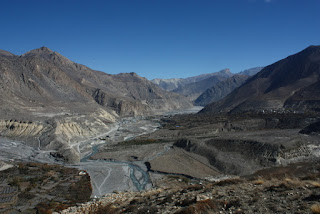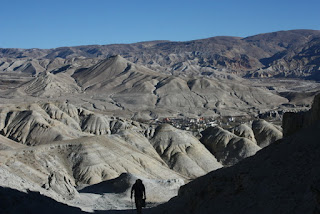Friday, November 18, 2016
Apres Trek Continued - Pokhara and Further East
Wednesday, November 16, 2016
Reflections on Trekking in Nepal's Mustang Region
Sunday, November 13, 2016
Nepal - Apres Trek
So, after spending almost 3 days in Jomsom, we left, happily, at 7 am on Sunday, for a 20 minute flight to Pokhara.
Tuesday, November 08, 2016
The Last Forbidden Kingdom - Trekking in Nepal's Mustang Region - 3
Saturday, November 05, 2016
Biking in the Kathmandu Valley
 |
| Sunrise over the Himalaya |
 |
| Monsatery at Namo Bhudda |
 |
| Bhaktapur |
Pokhara to Kathmandu by Land
Although it is easiest to fly between these two cities, we had decided to take the bus. It's less expensive but in particular it gives you some exposure to rural Nepal.
I can report that the trip took all of 9.5 hours. That included two toilet breaks of 20 and 10 minutes each, a lunch break of 1 hour and an unscheduled wait of another 1 hr 46 minutes waiting for a connecting bus to reach us from Chitwan. This latter "situation" was exactly the kind of thing I was somewhat worried about. Recall that the Maoist-led transportation strike, or bandh, was still on. Apparently, angry that the bandh was being broken, a crowd attacked a bus and burned it. This blocked the road and delayed the connecting bus that we were waiting for.
The road between these two cities is pretty bad. To start with, Nepal's terrain dictates a narrow, winding track to begin with. The state of the paving ranges from mildly poor to shockingly awful, considering this is the main highway between the two largest cities in Nepal. There were few places where the bus could travel faster than 50 km/hr. Often it was slower much slower. So even though we only had 200 km to travel, progress was slow.
Add to that a mix of cattle, goats and other livestock occasionally blocking the way. People also live along the highway, often literally on it. There were people walking, alone or in groups, biking, playing ...carrying crops, fixing vehicles... The bus had to navigate all this on a pavement barely 2 narrow lanes wide, with generous use of its uniquely Asian horn.
Finally we crested the hill bordering the Kathmandu Valley, past a final police checkpoint and into the chaos of Kathmandu itself. Earlier problems now became much worse. More pedestrians, more motorbikes, buses and trucks. If you haven't seen a chaotic 3rd world city, it is difficult to imagine how bad it really is.
The bus finally delivered us to the "station" and, slightly disoriented, it only took a couple of false starts before we headed in the right direction, into the inner chaos that is Thamel. Once landmarks were found, our hotel was quickly located and the trip was finally over. Our hotelier recognized us from our earlier visit and we were placed in the same room we had occupied nearly 4 weeks previously. Good pizza and a beer completed the day.
The Last Forbidden Kingdom - Trekking in Nepal's Mustang Region - 2
 |
| Kali Gandaki Valley near Kagbeni |
Tuesday, November 01, 2016
The Last Forbidden Kingdom - Trekking in Nepal's Mustang Region I
 |
| Our view of Kagbeni back in November 2013 |








































